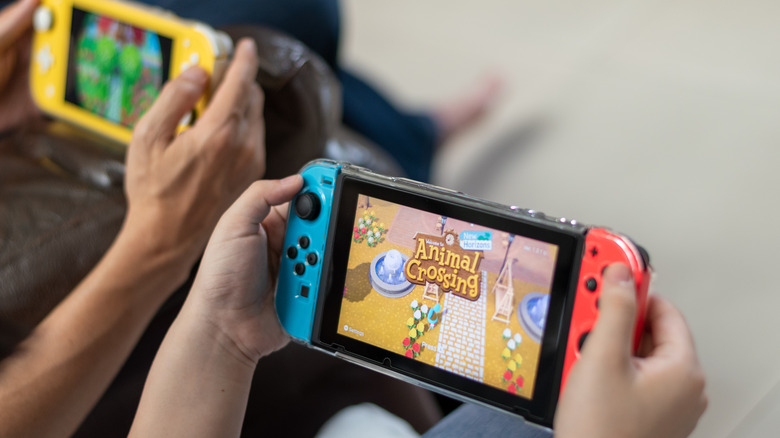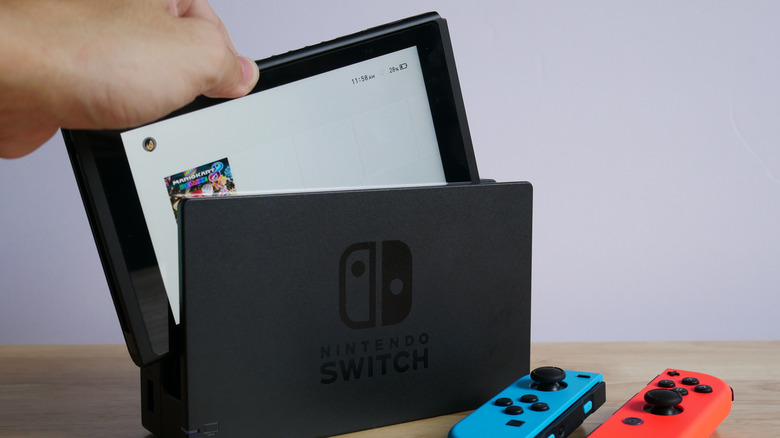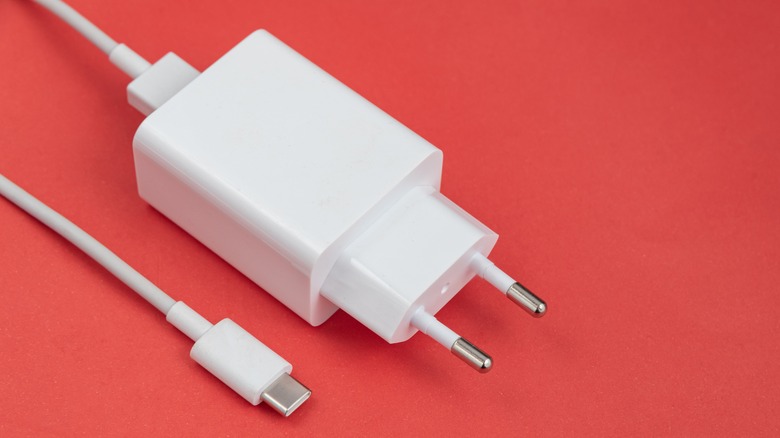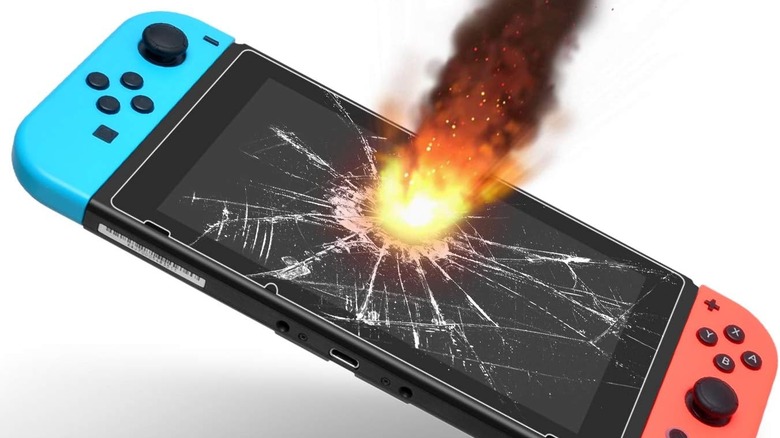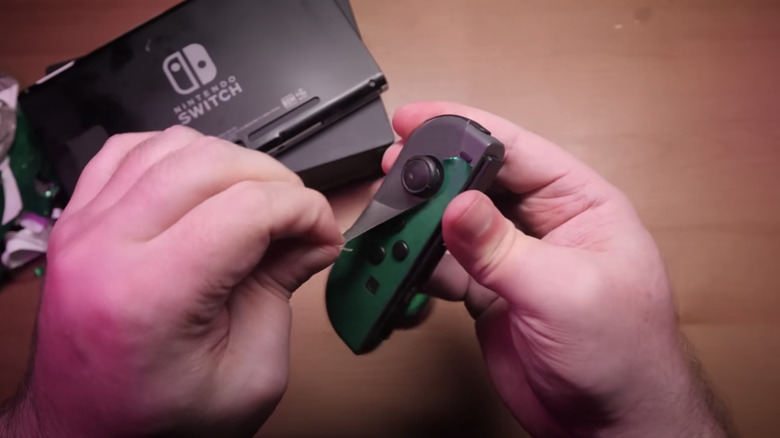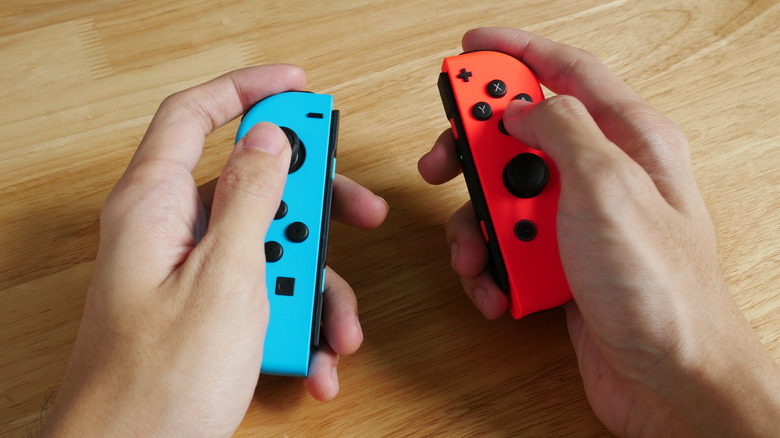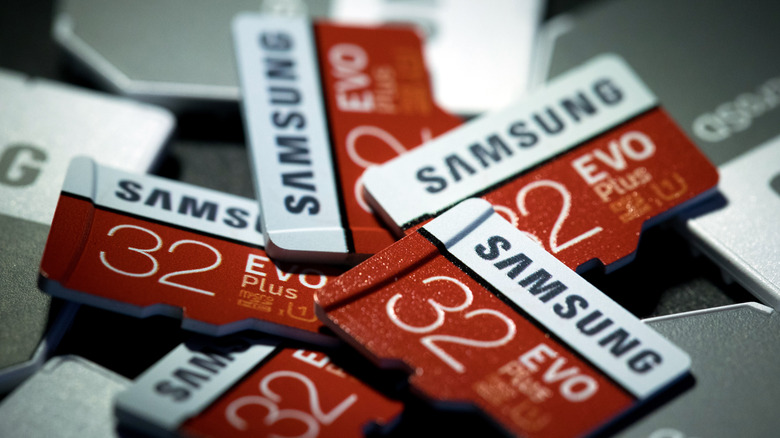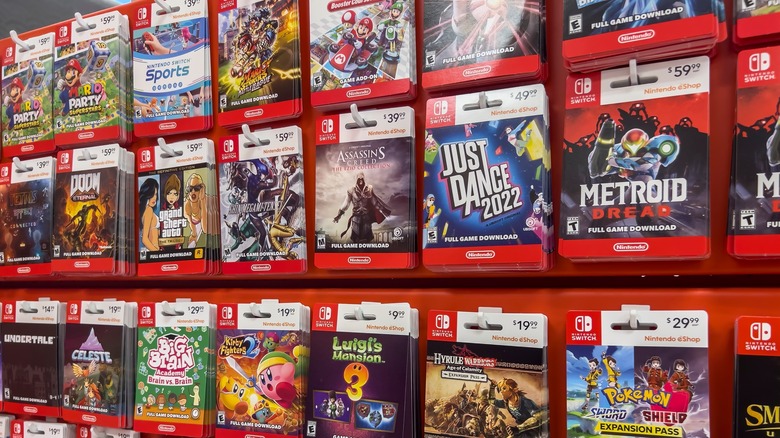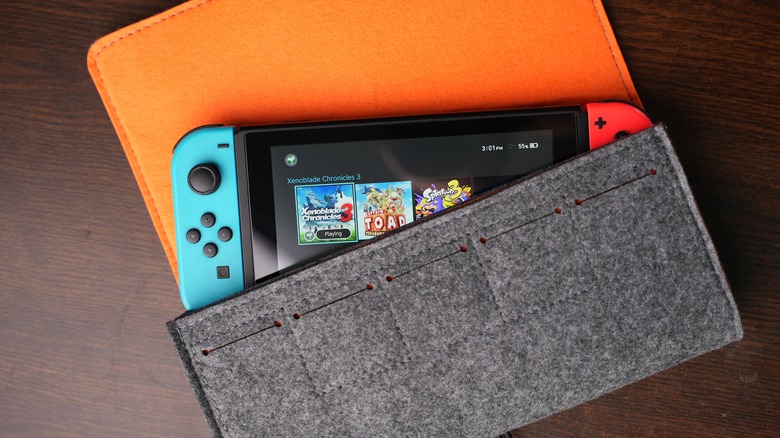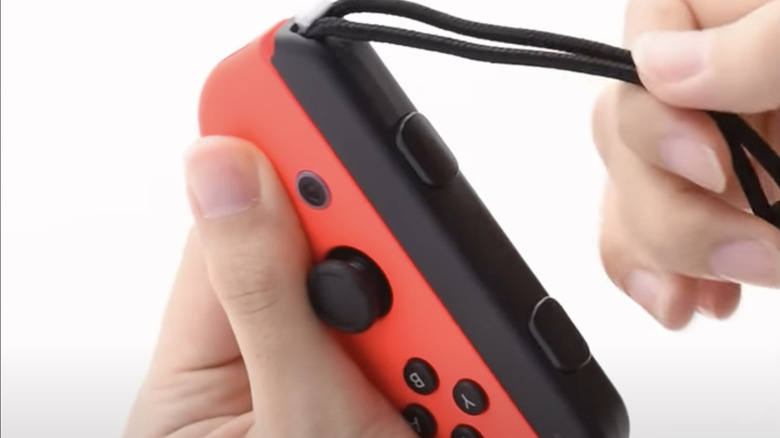10 Things You Should Stop Doing On Your Nintendo Switch Immediately
We may receive a commission on purchases made from links.
The optimization of the gaming experience is a constant battle for video game console owners, particularly those who own a Nintendo Switch. With over 125 million consoles sold as of May 2023, the Switch continues to be one of the most visible pieces of video game hardware on the market. However, even as the demand for the Switch (at least in its current form) starts to stabilize, the need for responsible and informed usage will always exist.
Maintaining a secure and enjoyable experience will always be paramount, and with the massive amount of Nintendo Switch content on the web, it is essential for Switch users and Nintendo Online members to be able to differentiate fact from fiction with their Nintendo Switch, Nintendo Switch Lite, or Nintendo Switch OLED model.
Many recommendations for what not to do with a console like the Nintendo Switch are obvious. The Switch is not waterproof or fireproof, and while there are several add-ons that can be applied to improve system durability, the console should still be handled with the utmost care to ensure its proper function. Instead, this list will instead discuss some "bad habits" Nintendo Switch owners might engage in, and why they may be detrimental to the health of their console. Understanding the consequences of these types of actions can not only protect your Nintendo Switch from harm but become the catalyst for better habits that can be applied to a host of different devices.
Here are 10 things you should never do with your Nintendo Switch.
Use third-party docks
Back in 2018, many of those who purchased third-party Nintendo Switch accessories, namely third-party Switch docks, reported "bricked" consoles to the video game news website Kotaku as a result of using the accessories. Nintendo has long discouraged the use of third-party products for reasons both rooted in business and practicality. The term "bricked" usually refers to consoles that have been rendered unusable, completely inoperable, or unresponsive, essentially turning into a "brick" with no function other than consuming space. When a console is bricked, it is unable to boot up, load the operating system, or perform any functions it was designed for. In some cases, "bricking" a console could void the warranty.
Not all Nintendo Switch owners buy their consoles new. For some, there may be an incentive to buy the standalone console used, opting for a cheaper dock from a reputable manufacturer of third-party accessories, such as Nyko. However, several gamers reported "bricked" Switch units following the 5.0 firmware update in 2018. Nintendo confirmed this suspicion to Kotaku itself, and while it offered to repair any "bricked" consoles under warranty, it also clarified its company stance on third-party accessories.
"Unlicensed products and accessories do not undergo Nintendo's testing and evaluation process," the company said. "They might not work at all with our game systems, and they could have compatibility problems with certain games, the Nintendo Switch system itself, and other licensed accessories and peripherals." While third-party docks have begun to surface that have been tested to not "brick" Switch consoles, Switch owners are advised to play it safe if they can help it.
Use third-party chargers
Like third-party docks, third-party chargers can also run the risk of "bricking" a Nintendo Switch console, and owners are advised to avoid them. While chargers of the off-brand variety have drawn satisfactory to positive reviews from most users, the "bricking" issue is directly related to the Switch's power supply and how much power the system can accrue directly and through its dock.
Ars Technica detailed the root of the issue with the help of the Redditor, "VECTORDRIVER," finding that the Switch's M92T36 Power Delivery chip can frequently burn out due to third-party equipment. The Switch can take a maximum wattage of 6V at a time, and any additional wattage could potentially fry the power delivery chip, rendering the console unusable.
Although the purpose of a charger (delivering power to a device) seems simple on the surface, several components go into the voltage a charger can output and how safely and efficiently it can charge a device. Not all USB-C chargers are created equal. That said, not all Nintendo Switch users have had issues with third-party chargers they have tried with their consoles.
Nevertheless, the best way to ensure the safety, longevity, and optimal performance of the Nintendo Switch, is to use only official Nintendo-branded chargers or those from third-party manufacturers with Nintendo's stamp of approval. Investing in a Nintendo-branded charger is a small price to pay to ensure the long-term health of your console.
Play without a screen protector
Nintendo Switch users are advised to invest in a screen protector, particularly in the case of the Nintendo Switch OLED. While the original Switch and Switch Lite models' screens are made of plastic, the OLED uses the more fragile material, glass. Glass is used to best facilitate the signature feature of the OLED: improved color reproduction and viewing angles thanks to OLED technology. The glass used in OLED screens is designed to be durable and scratch-resistant, but it may still be susceptible to scratches and damage if not properly protected. Luckily, Nintendo has supplied a discreet layer of film to go over the screens of OLED consoles, but alternative screen protectors can be just as effective.
While the original console and "Lite" variations of the Switch use a more durable plastic (polycarbonate), this material is likewise more susceptible to scratches than glass, so screen protectors are encouraged for all Switch models. Most screen protectors are straightforward to apply and do not leave any residue when removed. Once applied, they can have several positive side effects that extend beyond preserving the health of the screen.
Screen protectors can also prevent dust and debris from settling on the screen, which can accumulate over time and affect screen visibility. These are also typically affordable and easy to replace, and having one can preserve the resale value of the console in case Switch owners ever want to upgrade in light of recent rumors regarding the future of Nintendo's signature piece of hardware.
Buy Switch and Joy-Con skins
Skins for video game consoles and controllers have long been a part of the console-owning experience. However, several repercussions can come with applying skins to Nintendo Switch consoles, docks, and Joy-Cons that may persuade you to steer clear. The risks associated with these side effects are ultimately up to you, the console owner, to assess. But it is always crucial to vet the quality of a skin before purchasing and applying it to your accessories. Low-quality skins or improper installation can leave sticky residue on the surface of the console or accessories that, when removed, may be challenging to clean and could potentially damage the original finish or paint of the device.
This is particularly true given the Nintendo Switch dock, console, and Joy-Cons are made from different types of plastics. A top skin manufacturer known as Dbrand advised against skinning the Nintendo Switch and its accessories in a 2017 statement via Reddit, citing significant wear and tear on the plastic. While Dbrand now makes skins for the Nintendo Switch Joy-Cons that have been tested to not damage the hardware, not all skins from third-party manufacturers are correctly optimized for the Switch.
Some may continue to wear on the plastic, while others may be difficult to apply or remove without leaving marks on the hardware. As a result, it may be best to avoid skins altogether, instead investing in one of Nintendo's 20 different licensed pairs of Joy-Cons, creating their own color combinations along the way.
Discard Joy-Cons with Joy-Con drift
The Nintendo Switch Joy-Cons represent one of the Switch's most distinguished characteristics, as these are some of the most innovative, intuitive controllers on the market. However, the Joy-Cons have long been held back by one Achilles' heel: Joy-Con drift. Joy-Con drift refers to one or both of the Joy-Con controllers registering movement within its left or right stick without being physically moved.
This could cause the character or cursor on the screen to move or drift on its own, affecting the overall experience of the game and console. The problem often arises due to wear and tear on the joystick's internal components, particularly potentiometers that are responsible for detecting the direction and movement of the joystick. Over time, the potentiometers may become less precise or develop small inconsistencies, leading to unintended movement inputs.
Nintendo has long since acknowledged the Joy-Con drift problem on multiple occasions, and while there is no cure-all solution, Switch owners should not be so hasty as to discard their defective controllers or rush out to buy new ones. Nintendo is willing to provide free repairs to any and all licensed Joy-Cons, regardless of warranty, and there are likewise at-home solutions for repairing the issue. There are several tutorials for handy Nintendo Switch users on how to open the controllers themselves and remedy the problem. Regardless of your level of expertise, however, the prevalence of Joy-Con drift should not be a death sentence for your Joy-Con controllers.
Buy incorrect microSD cards
With the digital future as prevalent as ever, more and more console owners are turning to digital games to live on storage devices rather than keeping a physical game collection. Most Nintendo Switch games can vary in size, and while the OLED model upgrades the original Switch's internal storage by doubling up to 64GB, this will likely still not be enough if the Switch is your primary means of gaming. As a result, users have the option of adding microSD cards to improve storage. Except not all cards are created equal. While Nintendo has notably encouraged the purchase of first-party accessories, Switch owners should steer clear of cards with the Nintendo logo, as these are typically overpriced for the utility they actually provide.
The Nintendo Switch is compatible with third-party microSD cards, and the key for consumers is to find a card that provides the most amount of storage and write speed for its price, regardless of whether it comes stamped with the Nintendo logo. For instance, Nintendo sells a 512GB SanDisk memory card on its website with a 100 MB/s write speed for $119.99. However, Gigastone offers a microSD card through Amazon with identical write speed and storage space for $30 less when it is not on sale. Part of being a console owner is understanding where to splurge and where to save money. While there is value in buying Nintendo-branded docks and chargers, consumers should not fear the idea of third-party microSD cards.
Pay full price for Switch games
Nintendo made waves when it announced "The Legend of Zelda: Tears of the Kingdom," the sequel to one of the console's best-selling games, at a retail price of $69.99. Major triple-A titles have long retailed for $59.99, dating back to the seventh generation of consoles, and for as much content as "Tears of the Kingdom" has, the prevailing thought has been that a $69.99 price point could become the new normal. However, Nintendo Switch users should not fret, as there is little reason to buy Switch games, used, new, physical, or digital at full price.
The Nintendo Switch e-Shop is rife with sales and discounts on games from all developers, including Nintendo itself on occasion. Digital game consumers will want to pay close attention to the e-Shop during the summer months, during Black Friday and Cyber Monday, and following the Holiday shopping rush for the best deals on the highest quantity of games. However, digital consumers can also save on new titles thanks to the Nintendo Switch Game Vouchers program. For $99.99, Switch owners can redeem two Switch games digitally, saving them up to $20 on one title (or $10 on two titles, depending on your perspective). "The Legend of Zelda: Tears of the Kingdom" is an included game with this promotion, opening the door for savings of up to $29.99.
Used games, of course, will continue to be an option for those who prefer physical titles. And those who prefer new, physical games continue to have a slew of resources for discounts from different retailers.
Neglect the Switch's hidden features
The Nintendo Switch is more than just a video game console — it is also a piece of video game innovation for the versatility it offers to consumers. That said, there are plenty of hidden features to the console that Nintendo has not officially disclosed to its user base. Switch owners are doing themselves a disservice by not taking advantage of these features. One such feature allows users to turn on their TV with their Switch, though this must be enabled through the console's settings. Once Switch owners have navigated to "TV Settings" on their console, they can turn on their TV with their Switch by enabling "Match TV Power State," provided the dock is connected correctly.
Another little-known shortcut Switch owners can take advantage of has to do with the Switch sending screenshots to smartphones. By finding the "Sharing and Editing" menu through the photo album app in the bottom menu, Switch owners can send one or multiple screenshots directly to their smartphone using a QR code. Once the code is established, gamers can scan it with their phone, download the screenshots and share them wherever they choose from their mobile device. Of course, the Switch possesses several more hidden features, but the onus is on the user to seek out these avenues to get the most out of their console.
Transport without a case
There are plenty of obvious reasons for Nintendo Switch owners to have a suitable carrying case for their console, yet many do not as a means of saving money. However, given the Switch's utility as both a home console and a handheld, it would behoove all Switch owners to get their hands on a case to transport their console with as soon as possible. The type of carrying case consumers target for their Switch will depend on their needs. Some travel more than others, and Switch OLED owners may want to opt for something with a little extra protection given the device's glass screen. Others may have purchased a slew of different accessories to go with their Switch, and different carrying cases can accommodate different set-ups.
Having a case is the optimal way to protect your Switch on the go, protecting it from accidental bumps, scratches, and minor impacts during travel or when carrying it outside the house. Most cases are designed to be lightweight, portable, and there are plenty of additional options for personalization and customization. No matter whether on short outings or extended trips, a carrying case provides peace of mind, allowing gamers to enjoy their Nintendo Switch experiences worry-free wherever they go. A Nintendo-certified, deluxe carrying case can be had from Target at around a $40 price point, while more minimalistic cases can be had for under half the price.
Use Joy-Cons without a strap
One of the more overlooked aspects of the Nintendo Switch Joy-Con might be the straps that can attach to the right side of the left Joy-Con and the left side of the right Joy-Con. These straps can be purchased independently and are easily replaceable, but many will either play without the bumpers or attach the bumper while letting the strap itself dangle from the side. Nintendo had its reasons for implementing the Joy-Con strap — they are meant to improve grip and greatly reduce the risk of accidentally dropping the controller during a game.
There are also plenty of safety reasons associated with using the straps. The Joy-Cons feature motion controls and can even be used as makeshift Wii Remote controllers. As such, the straps function identically to the Wii's straps and are designed to prevent the risk of accidentally releasing them, reducing the risk of damage to people or third-party objects such as television screens.
The safety associated with the Joy-Con straps is particularly handy for families with small children, as less-experienced gamers can get a better handle on how the Joy-Cons work without the fear of accidentally dropping the device. By using the Joy-Con straps, Switch owners can enjoy a safer and more enjoyable gaming experience, whether at home or on the road.
